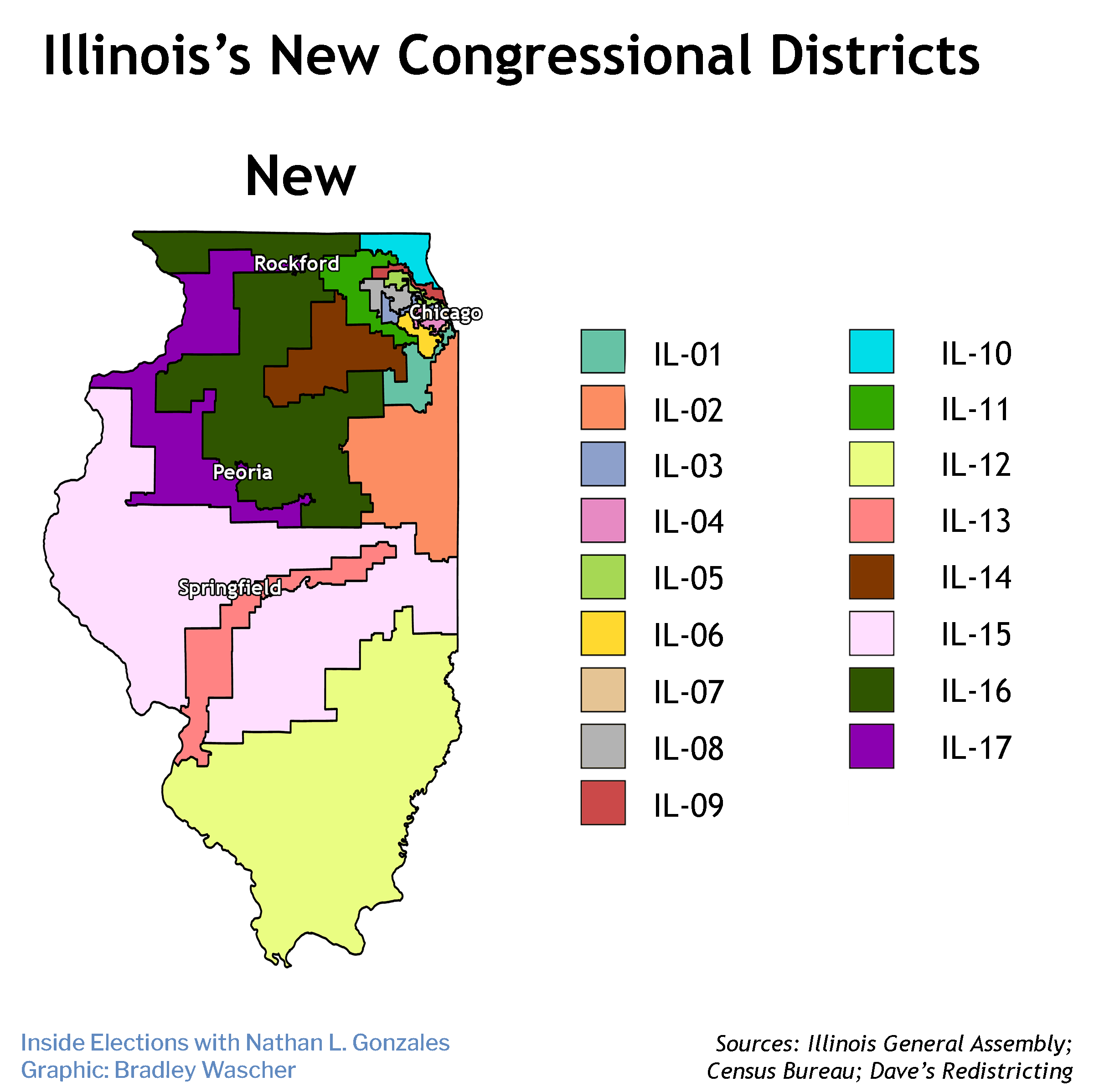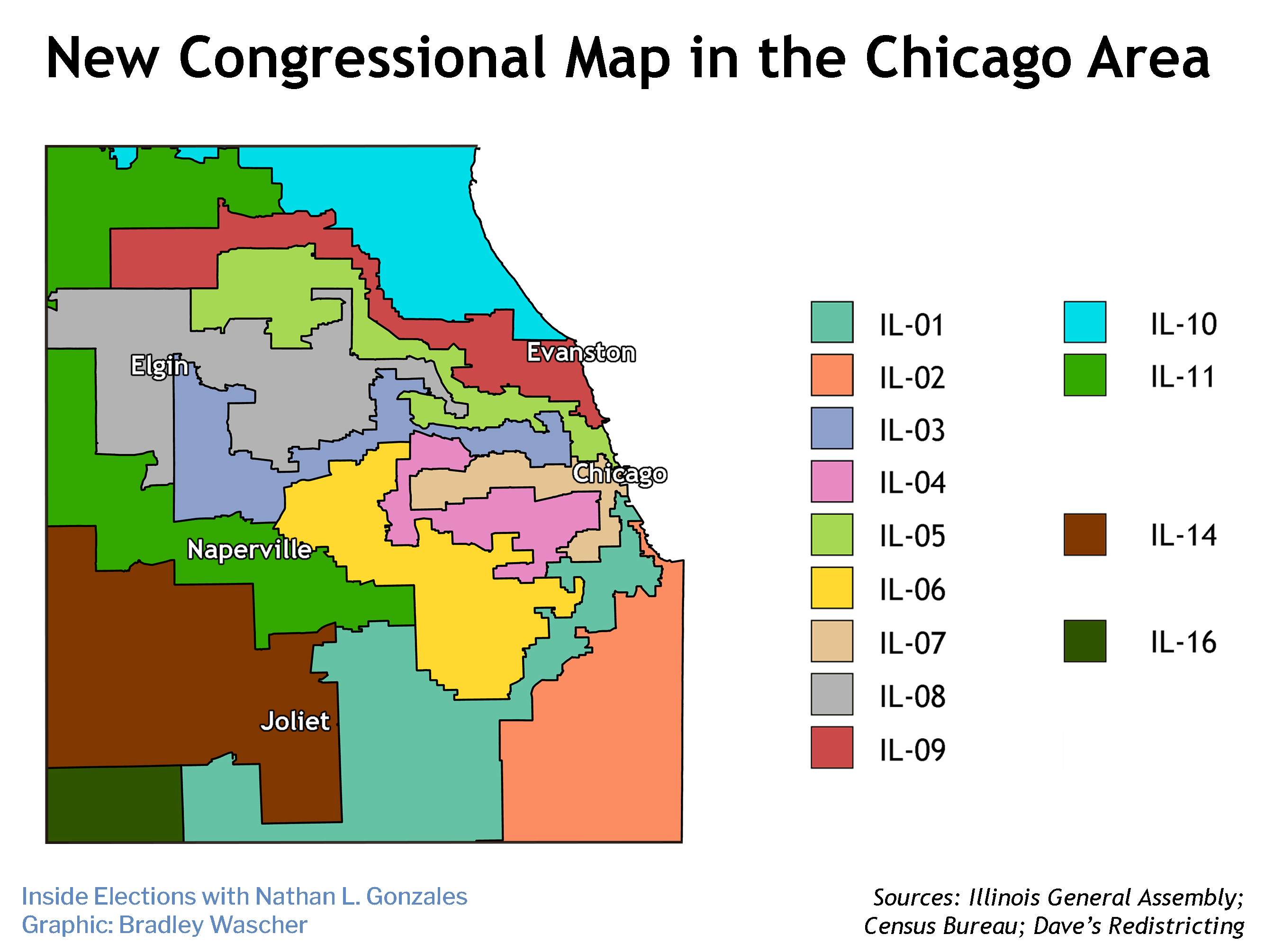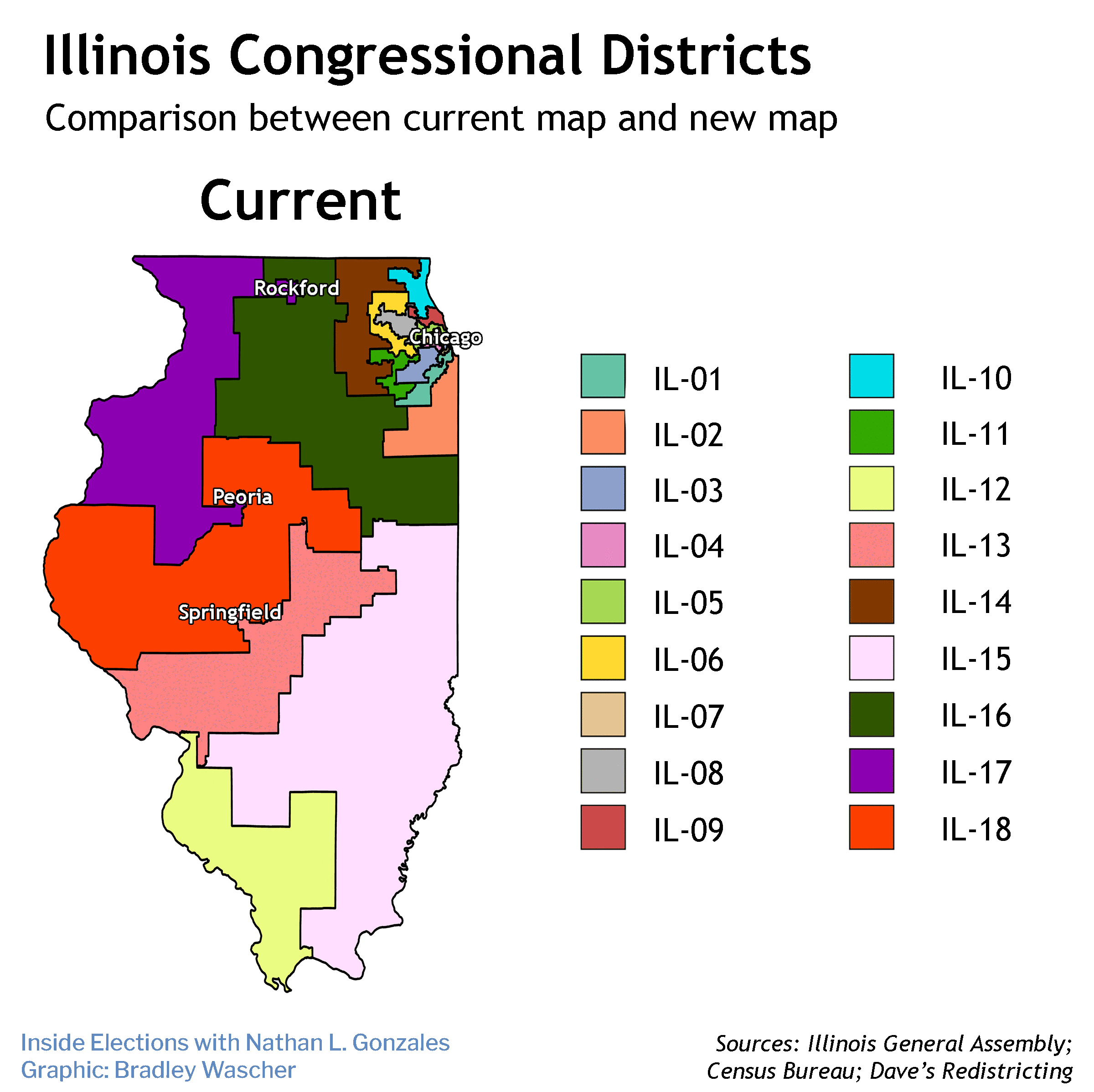Illinois Redistricting: Multiple Member-on-Member Matchups
January 28, 2022 · 1:52 PM EST
Although the new Illinois congressional map will solidify Democrats’ advantage for years to come, neither party left the redistricting process unscathed. From eliminated districts to double-bunked incumbents, the revised lines introduce new intrigue — and uncertainty — to Prairie State politics.
Illinois has lost at least one seat in every redistricting cycle since 1980, and the same held true this time. Beginning with the 2022 election, the size of the state’s congressional delegation will drop from 18 members to 17.
Democrats, in control of the redistricting process, took full advantage where they could. Vulnerable seats in suburban outskirts were shored up, a new district was designed for Chicago’s Hispanic population, and two GOP-held districts were essentially dissolved.
But losing a seat meant making compromises. In order to draw a map this aggressive, many reliably Democratic districts had to shed their margins by 5 or 10 points, to help make up the difference in more competitive seats next door. When paired with the creation and dissolution of entire seats , it makes sense how both parties will have to grapple with member-vs.-member primaries on June 28.
Currently, the Illinois congressional delegation is composed of 13 Democrats and five Republicans. Under the new lines, Democrats could realistically extend their lead to 14D-3R. At the same time, an additional seat or two could be in play for Republicans during an especially favorable national environment.

1st District
The 1st, which still covers much of Chicago’s South Side, has been slightly reconfigured to reach farther south into Kankakee County. Notably, Democratic Rep. Bobby Rush is retiring after 15 terms. A sizable field of Democrats has emerged to replace him, including state Sen. Jacqueline Collins and Chicago Ald. Pat Dowell; meanwhile, Rush has endorsed Karin Norington-Reaves, CEO of the Chicago Cook Workforce Partnership. The winner of that primary will almost certainly be the district’s next representative, as the 1st remains heavily Democratic. According to a composite average of federal and statewide elections in Illinois between 2016 and 2020 calculated by Inside Elections, the new 1st has an average partisanship of D+48.6, and it would have voted for Biden by approximately 43 points in 2020. Initial Rating: Solid Democratic.
2nd District
The 2nd retains much of its Southeast Chicago identity, and now stretches as far south as Vermilion County. By taking in additional areas of the Republican-leaning counties south of Chicago, the new lines are slightly less favorable for Democrats, but that shouldn’t cause much concern for Rep. Robin Kelly. Overall, the 2nd preferred Democrats by an average of 44.4 points in the composite of 2016-2020 elections, and Biden would have carried the heavily Black district by around 41 points in 2020. Initial Rating: Solid Democratic.
3rd District
The 3rd is a new seat created with Chicago’s Hispanic population in mind. Specifically, the district includes many of the city’s Puerto Rican communities in the northwest, while continuing farther west across DuPage County. With an average partisanship of D+43.2 according to the composite of 2016-2020 races, the district is heavily Democratic; it would have voted for Biden by 42 points in 2020. Democrats running in the primary include Chicago Ald. Gilbert Villegas and state Rep. Delia Ramirez. Initial Rating: Solid Democratic.
4th District
Situated in the southwest of Chicago, the 4th maintains a large Hispanic influence, but there are a few key differences. The district’s current lines, known for their characteristic earmuff shape, were redrawn to make way for the new 3rd District, effectively turning the 4th from an earmuff to an Airpod. In particular, the new 4th keeps the Mexican communities in the lower muff, meaning it will also probably keep Democratic Rep. Jesus “Chuy” Garcia. It was initially believed that Garcia might face Democratic Rep. Marie Newman, who represents the current 3rd District and was drawn into the new 4th, in a member-vs.-member primary, but Newman has since announced that she will be running in the 6th District instead. This should hand Garcia an easy third term in this Biden+47 seat that preferred Democrats by an average of 49.9 points in the 2016-2020 composite of election results. Initial Rating: Solid Democratic.
5th District
The 5th, home to much of Chicago’s North Side, now snakes farther north into Lake and McHenry counties. In terms of partisanship, the district remains a Democratic stronghold: the new 5th had an average partisanship of D+33.8 across all statewide elections between 2016 and 2020, and it would have voted for Biden by approximately 40 points in 2020. Democratic Rep. Mike Quigley is in no apparent danger. Initial Rating: Solid Democratic.
6th District
The 6th sits in the suburbs southwest of Chicago. While the district still retains portions in eastern DuPage County, the new map extends well into Cook County, partially to make way for the new 3rd District to the north. Due in part to this shuffling, Democratic Reps. Marie Newman and Sean Casten both find themselves running in the same district — setting the stage for a member-vs.-member primary.
Looking mainly at geography, Newman might begin with an edge: approximately 43 percent of the new 6th comes from land in her current district, compared to 24 percent of the new 6th coming from Casten’s current district, according to Daily Kos Elections. But Newman is under investigation by the House Ethics committee for allegedly offering a job to a potential challenger. Whatever happens, the eventual winner of this primary has a strong shot in the general election: the 6th preferred Democrats by an average of 10.4 points in the composite of 2016-2020 races, and Biden would have won the district by 11 points in 2020. Keith Pekau, the mayor of suburban Orland Park, is the top GOP fundraiser. Initial Rating: Likely Democratic.
7th District
Compared to the other Chicagoland seats, the 7th, which covers downtown Chicago and portions of the West Side as well as Oak Park, saw few changes. With an average partisanship of D+71.5 according to the 2016-2020 composite, this is Illinois's most Democratic district; Biden would have carried it by 74 points in 2020. But Rep. Danny Davis isn’t completely out of the woods. The 13-term Democrat, who will be 81 years old on Election Day, faces a spirited primary challenge from the left in the form of gun control advocate Kina Collins. Collins previously ran against Davis in the 2020 primary, finishing with just under 14 percent, but outraised the congressman nearly 2-to-1 over the first nine months of the year. Initial Rating: Solid Democratic.

8th District
Located in the suburbs northwest of Chicago, including Schaumburg, the 8th remains split between Cook, DuPage, and Kane counties. Voters, however, likely won’t be split on re-electing Democratic Rep. Raja Krishnamoorthi to a fourth term. Although the 8th did move a few points toward Republicans after redistricting, the new lines still preferred Democrats by an average of 14 points in the 2016-2020 composite of election results. Even in an especially unfavorable climate for Democrats, it’s difficult to imagine Krishnamoorthi, and his consistently impressive fundraising prowess, feeling much heat in this Biden+16 seat — especially considering Republicans didn’t even field a challenger in 2020. Initial Rating: Solid Democratic.
9th District
The 9th contains many of the communities just north of Chicago, including Evanston and Glenview. Formerly confined only to Cook County, the district now extends farther north into Lake and McHenry counties. Democratic Rep. Jan Schakowsky seems well positioned for re-election in this Biden+42 district that preferred Democrats by 39.9 points across an average of all federal and statewide elections between 2016 and 2020. Initial Rating: Solid Democratic.
10th District
The 10th is the northeasternmost district in Illinois. Already centered around Lake County, the district also now extends into McHenry County. And it remains reliably Democratic: the new 10th would have voted for Biden by around 26 points in 2020, with an average margin of D+17 in the composite of races between 2016-2020. Democratic Rep. Brad Schneider likely won’t have much to fret over. Initial Rating: Solid Democratic.
11th District
Although the 11th maintains its anchors of Aurora and Naperville, the district’s lines are otherwise a bit different. Namely, the 11th no longer extends south toward Will County and Joliet, but instead veers northwest into the less populous McHenry and Boone counties, both of which are heavily Republican. This puts Democratic Rep. Bill Foster in a more competitive seat. Still, the 11th’s average partisanship was D+8.7 according to the composite of 2016-2020 races, and Biden would have carried the district by 15 points in 2020. Foster, who has earned at least 60 percent in his last three elections, still looks like the favorite. Initial Rating: Solid Democratic.
12th District
The new 12th spans all of southern Illinois, absorbing over a dozen additional counties and losing the suburbs east of St. Louis. This reconfiguration now makes the 12th the most Republican-leaning seat in the state: it has an average partisanship of R+29.6 in the 2016-2020 composite, and it would have voted for Trump by approximately 43 points in 2020. That’s good news for Republican Rep. Mike Bost. Possibly even better news for Bost is that he’ll have the primary to himself, because Republican Rep. Mary Miller, who represents the current 15th District, was drawn into the new 12th but will instead run in the new 15th. Initial Rating: Solid Republican.
13th District
Now a thin strip running through central Illinois, the 13th keeps Springfield and Champaign, while adding portions of East St. Louis. Together, these changes swing the district’s partisanship nearly 15 points toward Democrats, resulting in a Biden+11 seat that would have voted D+15.2 in the 2016-2020 composite of election results. In light of these changes, Republican Rep. Rodney Davis has decided to run in the new GOP-favored 15th District, leaving an open seat. Although a handful of candidates are running in the 13th, the most prominent is Democrat Nikki Budzinski, a labor activist and former executive in the Office of Management and Budget. Jesse Reising, a former DOJ prosecutor and current partner at Kirkland & Ellis, is running as a Republican, as is philanthropist Regan Deering. Simply put, the new 13th District was designed to be a Democratic pickup, and Democrats have already appeared to have rallied around a candidate. Even in a strong year for Republicans, this will be one of the more difficult seats in Illinois to remove from the Democrats’ column. Initial Rating: Lean Democratic.
14th District
The 14th, a suburban Chicago seat, has been redrawn around its center, Kendall County. The district no longer reaches north toward McHenry County, but now spans west toward Bureau and Putnam counties. These changes should shore up Democratic Rep. Lauren Underwood, who flipped the seat by 5 points in 2018 and secured a second term by 1.3 points in 2020. The new 14th preferred Democrats by an average of 11.9 points in the 2016-2020 composite, and the district would have voted for Biden by approximately 12 points in 2020. Underwood certainly has the capacity to reach similar margins, but the uncertainty of the new lines, paired with a likely favorable national mood for the GOP, could make this one of the more interesting congressional races in Illinois. Initial Rating: Lean Democratic.

15th District
Wrapping around the heart of the state, the 15th takes in many of central Illinois’s rural counties. The result is a heavily GOP district: the new 15th would have voted for Trump by 39 points in 2020, with an average margin of R+28.1 in the composite of races between 2016 and 2020. But while the result of the general election is practically presaged, the primary will prove to be more important, as it will feature a member-vs.-member matchup between Republican Reps. Mary Miller and Rodney Davis. Miller, who is in her first term, has attracted controversy since taking office. Davis, now in his fifth term, has less baggage but Miller represents more of the new district and has been endorsed by Trump for the June 29 primary. Initial Rating: Solid Republican.
16th District
The 16th moves slightly south compared to the current map, trading Iroquois County for Marshall and Woodford counties, while also taking in the upper half of Peoria County. The addition of Peoria County opens the door for Republican Rep. Darin LaHood, whose current 18th District was eliminated in reappointment, to switch seats. Likewise, Republican Rep. Adam Kinzinger, a longtime critic of Trump, also saw his district effectively eliminated — possibly further motivating Kinzinger’s decision to not seek re-election. With Kinzinger out, it should be smooth sailing for LaHood: the 16th has an average partisanship of R+20.2 in the 2016-2020 composite and would have voted for Trump in 2020 by approximately 21 points in 2020. Initial Rating: Solid Republican.
17th District
The 17th is located in northwestern Illinois. Following redistricting, the Quad Cities seat lost much of its land from smaller counties, including all of Jo Daviess County, but in return, it now takes in more of Peoria in the south and Rockford in the north. Although these adjustments make the 17th a few points more favorable for Democrats, Democratic Rep. Cheri Bustos is retiring. Bustos had a close call in 2020, winning with only 52 percent. Her Republican challenger, Army Reserves member Esther Joy King, is running again this year. On the Democratic side, former state Rep. Litesa Wallace has received a number of endorsements from Illinois Democrats. Rockford Alderman/Afghanistan veteran Jonathan Logemann, Rock Island County Board Member Angie Normoyle, and former WQAD meteorologist Eric Sorensen are running as well. Adding to the uncertainty is the partisanship of the district itself. The 17th preferred Democrats by an average of 9.5 points according to the composite of 2016-2020 races, and Biden would have carried it by 7 points in 2020 — but this still looks to be the most competitive seat in the state, especially amid a strong climate for Republicans. Initial Rating: Tilt Democratic.